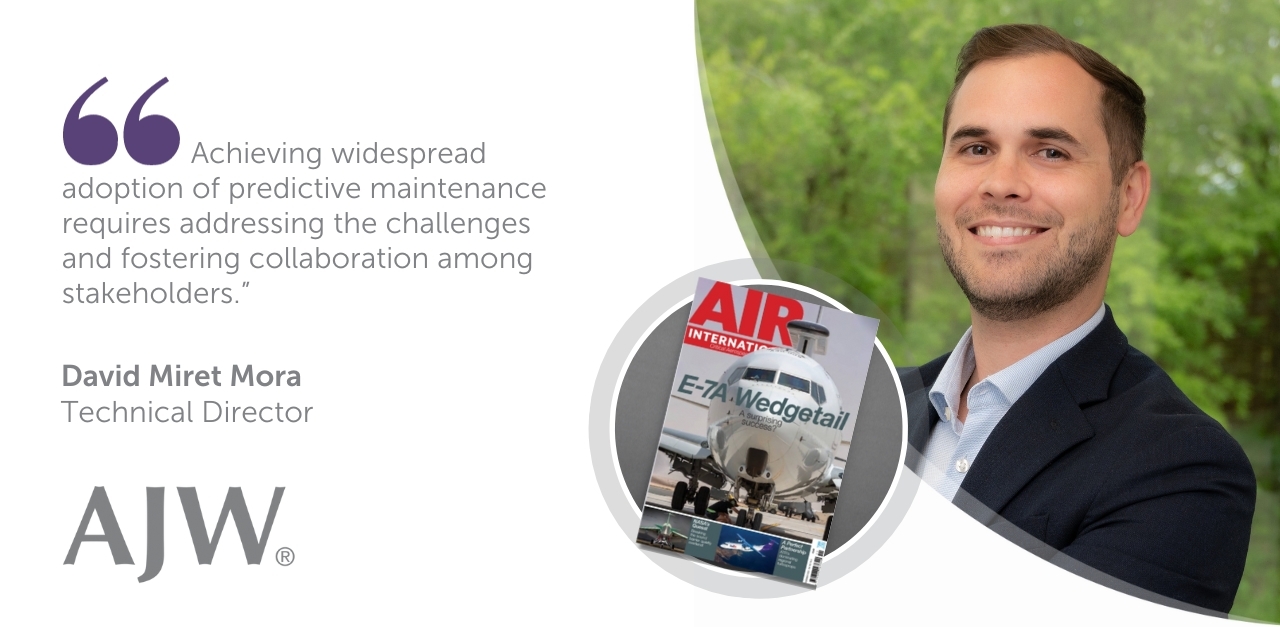

24/7 AOG Critical Response
Hotline![]() UK +44 1403 798888US +1 877 780 2008
UK +44 1403 798888US +1 877 780 2008
Our award winning global AOG service is manned 24 hours a day, 365 days a year.
Please call +44 1403 798888 or email aog@ajw-group.com.

17 Nov 2023

Having an aircraft-on-ground (AOG) situation is something no operator wants. Time is money and can result in dissatisfied customers and can impact an airline’s performance. With the emergence of predictive aircraft maintenance and a just-in-time replacement of parts, AOG situations may become a thing of the past, but how close are we to this becoming a reality?
In the December issue of Air International, journalist Bernie Baldwin speaks to AJW Technical Director David Miret Mora about diagnosing problems in advance to prevent costly groundings.
The aviation industry is seeing a growing trend in predictive aircraft maintenance and advanced diagnostics to improve maintenance efficiency and reduce repair costs. As technological innovation introduces crucial advancements, the industry awaits the time when proactive repairs and replacements will put an end to reactive repairs by predicting problems before they occur.
“The benefits of data analytics and predictive maintenance in aviation are numerous. By improving the reliability of aircraft and equipment, airlines can reduce the likelihood of delays and cancellations while also increasing safety for passengers and crew,” says AJW’s Miret Mora.
The Group’s Technical Director firmly believes that predictive maintenance holds exciting potential for the aviation industry. He does warn that due to the complexity of the technology, its adoption is not going to be easy. “Presently, aviation regulations lack a defined PdM (Predictive Maintenance) structure, creating a significant barrier to its acceptance across different aviation key players,” he explains, “To unlock its benefits, a Predictive Maintenance framework is imperative to align stakeholders’ interests and establish a consistent maintenance strategy.”

Miret Mora discusses the history of predictive maintenance, dating its pioneers back to 1978, and speaks about the innovations and transformation processes that have brought the trending maintenance technology to where it is today.
“Traditional maintenance emphasises scheduled maintenance to achieve cost-effective airworthiness. PdM offers an analytical approach, potentially optimising maintenance by preventing premature or delayed component replacements.”
He suggests that formal research is still required in the field to make it truly viable.
The current lack of unity among stakeholders complicates matters. Airlines stand to benefit most from PdM, but its successful implementation requires industry-wide readiness and collaboration says Miret Mora. PdM’s emergence in aviation maintenance is still in its early stages, raising fundamental questions that demand collaborative solutions.
The industry has seen substantial growth in data with more technologically enabled aircraft now emerging. He offers insight saying, “A Boeing 787 with Rolls-Royce engines can generate 500GB of data per flight, and an Airbus A350’s 50,000 onboard sensors amass 2.5 terabytes of data daily. This data influx presents a major challenge – distinguishing critical information from noise.”
Miret Mora elaborates on this statement noting that the likes of Airbus and Boeing have refined their data analytics capabilities and have partnered with non-aviation companies to seamlessly integrate PdM software such as IBM, and Microsoft.
Predictive maintenance will only be successful if there is a cultural shift and Miret Mora. He divides industry adoption stakeholders into five categories that describe their levels of engagement with PdM technology.
“Achieving widespread adoption of PdM across all industry players requires addressing the challenges and fostering collaboration among stakeholders,“ he affirms and concludes by saying that “successful adoption hinges on technology acceptance, robust governance, and data quality – an essential step toward achieving the potential of predictive maintenance in aviation.”